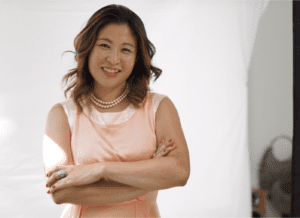Balancing the Grind with Helen Tarrant, Commercial Property Specialist

Source: https://balancethegrind.co/interviews/helen-tarrant-commercial-property-specialist/
As far as pathways to a $10 million-plus property portfolio go, you would be hard-pressed to find another as unique as Helen Tarrant’s.
Ms Tarrant arrived in Australia with her family from Beijing, China in the late 1980s, and like many migrants at the time, the family had little more than the clothes on their backs and the belongings in their suitcases.
Her upbringing in Sydney was nearly as volatile, as Ms Tarrant changed schools nine times and had to work three jobs while studying for her HSC to help her parents make ends meet.
A strong HSC score led to a Bachelor of Commerce degree from Australian National University, which Ms Tarrant followed up with a Master of Laws.
At the same time she was studying for her law degree, Ms Tarrant established a successful beauty salon business, which over time grew to three locations and became a Registered Training Organisation.
And while many would have been satisfied with that high level of success, Ms Tarrant decided she wanted more, and started to ponder the possibilities of property investment.
Those thoughts turned to commercial property while working as a therapist at the beauty business, when Ms Tarrant said she realised that she had to work a day and a half just to pay her rent.
“Our landlord would come down once a week and collect the rent from us, they would collect the rent from the hairdresser, then go upstairs and collect rent upstairs, and then go off fishing for the rest of the week,” Ms Tarrant told Australian Property Investor Magazine.
“I thought that was a pretty good lifestyle and I got to thinking about how I could achieve that lifestyle for myself.”
In 2012, Ms Tarrant decided to take the leap, buying a restaurant premises in North Sydney for $360,000.
“It was 55 square metres, and pretty much at the time the choice was: get an 8 per cent net yield in commercial, or a 5 per cent gross yield in residential, in the same suburb basically,” she said.
“I knew nothing about commercial property at the time, but the cash flow was so attractive I was wondering why nobody had ever told me about it before.
“It was really one of those things that you really don’t know what you don’t know and you learned along the way.
“There was no education, there was no one to tell you what to invest in, the agent basically threw you a contract and said ‘the first person to sign the contract gets the property’.
“You’re basically rushing against time and you don’t know what to ask.
“Since then I’ve made mistakes and there have definitely been deals where I could have done better, but I realised that if you are going to invest in commercial property you have got to be willing to learn a little bit more about it and willing to engage with professionals so you can actually find the right deal for you.”
Ms Tarrant’s investments proved savvy, and by utilising the mounting cash flow, she was able to build a $10 million-plus portfolio within just five years.
With that base, she established buyers agency Unikorn Commercial Property, which specialises in helping everyday investors build passive income through the commercial realm.
Ms Tarrant said one of the keys to her success was an analytics-driven approach and a willingness to take a chance on an investment when others wouldn’t.
“Every case is different in commercial property, you just have to assess it on an individual basis and not let your preconceptions taint it,” she said.
“In residential property, people talk about the property clock, but in commercial, it’s really about the tenant cycle, whether they are coming into the lease or exiting the lease.
“And the classes of properties, whether that’s retail, office or warehouse space, tend to go in cycles.
“Right now, people don’t want to invest in office space, which means two years from now when we are in a different work format, where there are a certain amount of people who have gone back to the office and where we have learned to live with COVID, you are likely going to get a higher return by investing in office space.”
Ms Tarrant said there were four key pillars to her investment strategy; fair market value, the tenant and the length of the lease, the property’s location and what type of commercial property the asset is.
Fair market value, Ms Tarrant said, is one of the hardest things to determine in today’s ultra-heated investment space, but the other three metrics are relatively easy to understand.
“When we’re looking at tenant and lease, we are considering whether it is a brand name tenant such as Chemist Warehouse or a franchise like McDonalds, or are we talking about a mum and dad-owned takeaway shop?
“They are significantly different in people’s perception of how secure they are.
“Lease term – are we talking a one year lease or are we talking a 10-year lease to a medical centre? Again, that changes perception.
“There’s a lot to look at in location; is it freestanding, is it strata, is it on a major freeway, is it in a major city or a regional town?
“And then you add the type of property – is it a warehouse, retail, residential converted to commercial, or an office space.
“It is all about getting the best deal in this market, because I still believe we’re not at the top of the market just yet.”
For those looking to take their first steps into commercial property, Ms Tarrant said the best strategy was to ensure the investment was as simple as possible.
“The number one thing I suggest is to look for a ‘set and forget’ type of property, one with a minimum of two to three years left on the lease,” she said.
“It would most likely be a strata-type property valued sub-$1 million, and you need to make sure it has a tenant that’s been in the property for three to five years and they are in at least their second term of the lease.
“I would also look for a property where the tenant has invested in a fit-out, is going to provide a cash flow from settlement, and you are paying market returns.
“Rather than just being trigger happy, which we are increasingly seeing in this market as people just want to buy something, the most important thing in commercial property is in strategy.”
The next step, Ms Tarrant said, was to apply some residential property investment principles in the commercial realm.
However, she cautioned that approach can start to get time consuming.
“For example, investing in a vacant property or one where you need to do an uplift or a refurbishment, or when you are turning one larger tenancy into two, as you would in residential, those things started to take time and I had to learn new skill sets,” she said.
“I also had to understand a lot more about how the tenancy worked and how the market worked.
“One of the things I’ve learned is that most of the time, your tenant is not going to default on the lease.
“Your tenant is there to realise their own dream, which is having their own business, having the autonomy of being their own boss and building an asset for themselves in a business sense.”
And while Ms Tarrant is a staunch advocate for commercial property investing, that’s not to say she doesn’t have experience on the residential side as well.
“I used to be a residential investor, and as of this year I have sold all of my residential properties,” she said.
“I would get into residential again, it’s not something I would discount, but residential is a vehicle for capital growth, whereas commercial property is a vehicle for cash flow.
“Ideally, the best strategy is to have both in your portfolio.
“If you have cash flow and growth in your portfolio you can continue to buy ad infinitum.
“Whereas if you only have one without the other, then at some point you come to a screeching halt.
Another key to commercial property investing, Ms Tarrant said, is putting together a long-term plan, and working out what type of property would help achieve specific goals.
“It is high risk and traditionally it has been the high net worth individuals who are invested in commercial property – it hasn’t been accessible to the everyday Australian,” she said.
“The misconception that everybody has about commercial property is that everyone wants to buy the big shiny object, they want to buy McDonalds or a child-care centre or a service station.
“But those types of properties provide very low returns and are very highly priced, so they are actually not affordable for the everyday Australian.
“If you go to auctions, these are priced anywhere from $5 million and upwards. It’s just not accessible.
“The average Australian commercial property is worth $500,000 to $1 million, that’s the average starter property.”
However, despite all the preparation and research Ms Tarrant had put into her own portfolio, as well as the research she did for her clients, she said the pandemic underlined that nothing is ever certain in the world of commercial property.
“What we have seen through the pandemic is that the tenants that used to be reliable before the pandemic may not be the tenants that are reliable after the pandemic, and that some tenants that weren’t reliable before COVID may have become your best tenants now,” she said.
“An example of this is before the pandemic, we were looking at putting one of our clients into a property that had a bike shop in it.
“It was a warehouse property in Queensland with a bike shop in it and our client’s concern was it wasn’t going to be a reliable tenant.
“We went and saw the property and said ‘look, the tenant is really good, they are really versatile, they do online classes and online sales and they do bike maintenance and repairs’, but they wouldn’t believe me.
“Then the pandemic hit, and bike shops shot up to become the number one most reliable tenant, they are the choice of tenant for people to invest in.
“We find that quite an interesting shift.”
Recommended for you

How a beauty therapist turned lawyer built a $10m-plus portfolio
A former beauty therapist who pockets nearly $700,000 a year…

Balancing the Grind with Helen Tarrant, Commercial Property Specialist
A former beauty therapist who pockets nearly $700,000 a year…

Beauty therapist reveals key decision that got her 20 properties worth $20m
A former beauty therapist who pockets nearly $700,000 a year…





